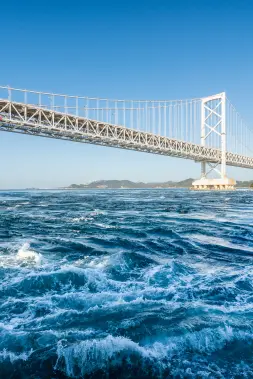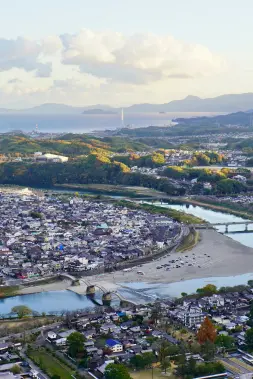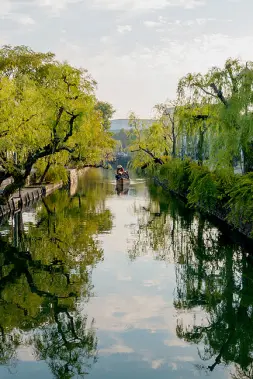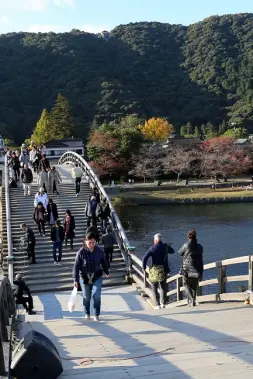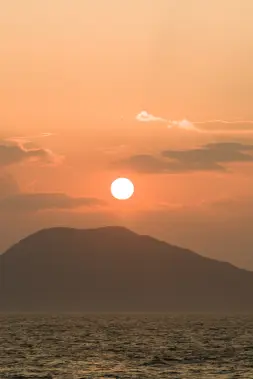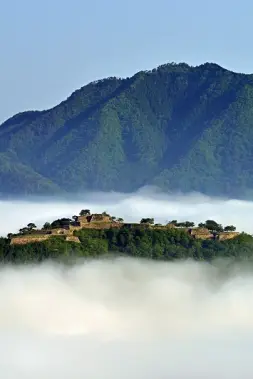Adventure & Experience
Hiroshima: Kosanji Temple and Hirayama Museum Along the Shimanami Kaido

-
- DESTINATION NAME
- Hiroshima
-
- RELATED TAGS
-
- LAST UPDATED
- 30 April, 2021
As once proclaimed in a famous Japanese haiku, “The Mothers of the world are as the Goddess of Mercy.” I imagined these words ran especially true with wealthy industrialist Kozo Kosanji, as I stood within the massive Kosanji Temple complex he built in devotion to his mother. At the heart of this extraordinary complex was an artistic and creative mind at work, something that I’d discover to be a common theme during my travels as I crossed the Shimanami Kaido (しまなみ海道). This 60-kilometer expressway links Hiroshima and Ehime prefecture (Japan’s main islands, Honshu and Shikoku, respectively) with a series of impressive cable-stayed bridges and roads spanning a chain of small islands. As I passed through picturesque rural towns and over spectacular ocean sceneries, I discovered the rich artistic heritage that blossomed on these islands and still grows today.
While all of these destinations are accessible by car, exploring these small islands by bicycle is ideal for fulfilling your art-infused expedition across the Shimanami Kaido. The first portion of my Shimanami Kaido adventure began at Hiroshima’s Ikuchi Island (生口島, Ikuchijima), where I visited the monumental temple complex of Kosanji Temple. I’d conclude this leg of my journey at the Hirayama Ikuo Museum for a glimpse at how the surrounding Setouchi seascape inspired the world-renowned artwork of local Ikuchi native, Hirayama Ikuo.
Kosanji Temple: A Grand Gesture of Love From Son to Mother
If I was asked to come up with a grand gesture of love for one’s mother, I’d have a hard time thinking of one more awe-inspiring than Kosanji Temple (耕三寺, Kōsan-ji). Founded in 1936, this massive four-level temple complex was built by a wealthy businessman, Kozo Kosanji, who began building the complex after his mother’s passing in 1934. For the next 30 years, this rich industrialist, who made his fortune running a steel pipe manufacturing business in Osaka, built over twenty structures on the 50,000 square meter complex in her honor. He even went as far as becoming a Buddhist monk to fully devote himself to pay his debt of gratitude for his mother. Now that’s some dedication!
It’s hard to tell just how large the entire complex is at the temple’s elaborately-designed main gate entrance. Included within the temple are a five-story pagoda, a towering 15-meter statue of Kannon, a Thousand Buddha Cave depicting scenes of hell, and structures modeled after Kozo’s mother’s favorite temple structures in Japan.
Among the most impressive I came across were the Koyomon Gate, modeled after Nikko’s golden Yomeimon Gate, and the Main Hall, modeled after Uji’s Byodoin Temple. These two structures bordered a large central plaza with a surrounding moat that flourishes with lotus flowers in late summer. While they weren’t in season in late February when I visited, I was treated to visions of plum blossoms throughout the complex.
Even if many of these structures of replicas of other famous structures in Japan, there is a distinctive “Kosanji” style that makes them entirely unique. Often, this Kosanji-style was more ornate and colorful than its original structures. As testimony to this, fifteen of these structures are classified as Important Cultural Properties, giving you another reason to make the trip to this one-of-a-kind temple.
The Hill of Hope: An Italian Marble Garden
As a collector of classical Japanese art, Kosanji’s artistic and creative influence takes it up a notch at The Hill Of Hope (未来心の丘, Miraishin no Oka), a 5,000 square meter park made entirely of imported Italian white marble. Located at the top of the Kosanji Temple complex, over 3,000 tons of solid marble was used to create this park, and it took 16 years for the sculptor, Itto Kuetani, to complete. A pair of abstract statues called the Tower of Light marks the very peak of the park, and as I’d see for myself, it was not only a popular place to get your photo taken but an excellent vantage point over the surrounding island landscape.
It was a wonderfully clear day when I visited, with the alabaster white marble against the blue sky. As I looked down from the superior view, the fields of citrus trees made me think of Italy’s pastoral grape-lined landscapes, and I couldn’t help imagine that it played a small part in sparking inspiration of this monumental park. Either way, there’s little doubt in Kozo’s enduring love for his mother.
Artistic Portrayal of Hiroshima Life and History at Hirayama Ikuo Museum
Continuing my art-infused visit to Hiroshima’s Ikuchi Island, I walked less than five-minutes to another of the area’s top art destinations, the Hirayama Ikuo Museum (平山郁夫美術館). This museum features the works of celebrated contemporary Nihonga (traditional Japanese painting) artist and painter Hirayama Ikuo. While the island native is renowned for his Grand Silk Road Series capturing his travels along the Silk Road, the Seto Inland Sea’s influence is not lost on his early subject matter.
In one of the museum’s main spaces, a large painting of the iconic Shimanami Crown Bridge dominates the spacious room. Another room showcases a progression of his artistic interests and styles, starting with childhood diary entries showing daily scenes of life with family and friends and transitioning into mature painting styles and self-portraits. I couldn’t help chuckling to myself as I looked at his early boyhood drawings of epic samurai fights (don’t we all go through this phase at some point in our lives?) and felt a heavy ache in my heart at paintings of charred fishing boats painted after WWII.
As a boy, Hirayama narrowly escaped the atomic bomb that was dropped on Hiroshima, though he suffered the effects of radiation sickness for the rest of his life. Rather than allow the tragedy of WWII to cast a darkened outlook on life, this event inspired him to focus on world peace and Buddhism. Eager to learn more about the roots of Japanese culture, Hirayama traveled to Turkey, Iran, India, and China to visit some of the ancient Buddhist sites that still existed there, which resulted in his famous “Silk Road” series.
While these later paintings have achieved more acclaim with the rest of the world, it’s the artist’s enduring practice of his art, from a young child to his older years, that truly captured my heart. Like Kosanji Temple, the small islands in the Seto Inland Sea seem to have a magical effect on nurturing artistic talents that are well worth the detour from mainland Japan. If grand gestures of world-renowned art don’t inspire a visit, the breathtaking natural landscape along the Shimanami Kaido surely will.
Shimanami Kaido Suggested Route and Map
With various starting points and means of access along the Shimanami Kaido, it’s easy to curate your own journey based on your pace, physical ability, or transportation mode. The Shimanami Cycle Website outlines a suggested Shimanami route to follow and lists the bike rental offices if you choose to complete your visit on two wheels.
How to get to the Shimanami Kaido using the Japan Rail Pass
The Shimanami Kaido expressway starts from Hiroshima’s Onomichi City to Ehime’s Imabari City which can access using the JR Pass. If you’re starting your journey at Onomichi port, catch the JR Shinkansen Train at Hiroshima Station (広島駅) headed to Tokyo and get off at Fukuyama Station (福山駅), transfer to the local train bound for Mihara to Onomichi Station (尾道駅) (54 minutes), then walk four-minutes to Onomichi Port Terminal (尾道港).
From Shin-Osaka, Kyoto, and Tokyo Station, catch the JR Shinkansen headed for Hakata, then transfer onto the local Sanyo line at Fukuyama Station (福山駅) until you reach Onomichi Station. It takes approximately 2 hours to reach Onomichi Station from Shin-Osaka and Kyoto, and 4 hours from Tokyo.
How to Get to Ikuchi Island
If you want to skip the 25 km distance of the Shimanami Kaido between Onomichi and Ikuchi Island, catch the ferry leaving Mihara Port (三原港) for a 44-minute ferry ride to Sawa Port, then walk (or cycle) the remaining one kilometer to Kosanji Temple and the Hirayama Ikuo Museum. This ferry is not covered with the JR Pass.
Whether you’re traveling by train, ferry, or bike, the Shimanami Kaido has a wealth of scenic beauty, celebrated cultural and artistic destinations, and impressive temple structures to easily leave you dreaming for more traveling within the Seto Inland Sea. For more recommended destinations along the Shimanami Kaido, continue to part two for my journey into Ehime prefecture.
RELATED DESTINATION
Hiroshima
Hiroshima is the central city of Chugoku region. Hiroshima Prefecture is dotted with Itsukushima Shrine, which has an elegant torii gate standing in the sea; the Atomic Bomb Dome that communicates the importance of peace; and many other attractions worth a visit. It also has world-famous handicrafts such as Kumano brushes.









































